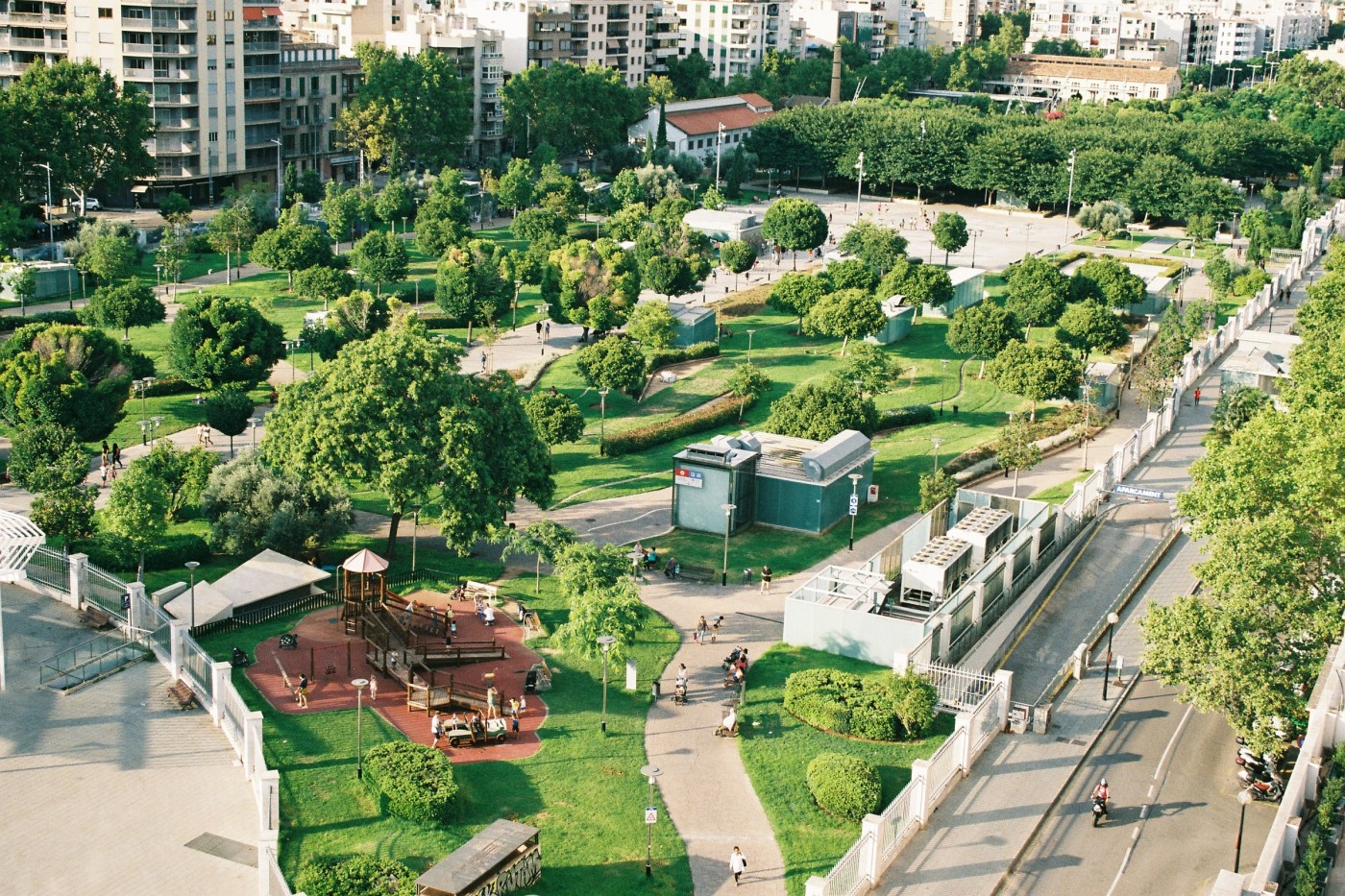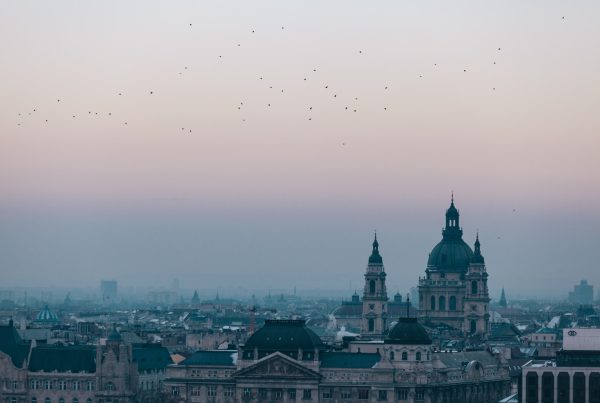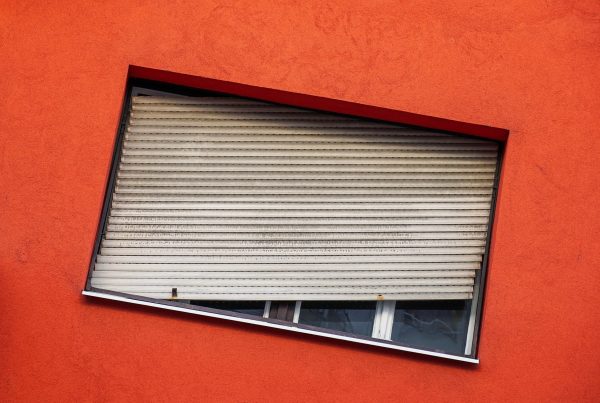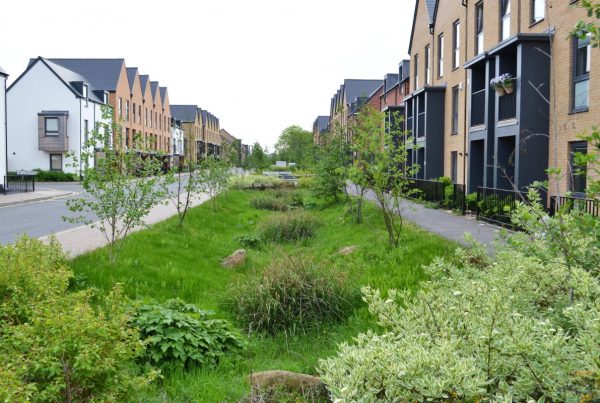NATURE-BASED SOLUTIONS 4.: Green infrastructure in the service of clean air
In the fourth article of the series about nature-based solutions (NbS), we examine how air quality is affected by the direct and indirect effects of built urban environment and infrastructure. Moreover, we present an array of available solutions in line with local and international best practices that make our cities more liveable, relying on certain chemical, physical and ecological phenomena of green infrastructure.
Access to clean air is a basic human right [1], however, nine out of ten people breathe polluted air today, globally [2]. It is especially true for high density residential areas, where air pollution levels are extremely harmful to our health in the larger part of the year.
Why is air quality so important?
Poor air quality is widely known to be damaging to human health. According to WHO data, some 400 000 premature deaths are caused by air pollution in EU countries annually– a figure more than ten times higher than that of road accidents [3]. Polluted air significantly increases the risk of cardiovascular diseases, pulmonary diseases, lung cancer, liver diseases and haematological diseases, in addition to being one of the main causes of respiratory diseases. Hungary stands well below the EU average, since, as the result of air pollution, the number of healthy life-years can decrease by more than 1.5 years per 100 people.

2/10
Figure 1: The number of healthy life-years lost due to poor air quality per 100 000 citizens in 2016. Source: WHO [4]
Air pollution is primarily dangerous for children, elderly people, expectant women, young mothers and people with respiratory conditions – however, socially disadvantaged populations are also vulnerable because they are more likely to live in environments lacking adequate health conditions. [5]
Why is the air quality of cities on a downward spiral?
The composition of air is determined by both natural and artificial processes, but air pollution caused by human activity is much more harmful in the long term. Cities of growing population and size are especially exposed to the detrimental effects of air pollution while also being responsible for the increased concentrations of carbon dioxide, carbon monoxide, nitrogen oxides, sulphur oxides, volatile organic compounds (VOC) and particulate matter (PM) – according to the most recently published IPCC report. Contemporary processes of urbanization, car-centric lifestyle and re-industrialisation jointly contribute to the worsening of air quality in settlements [6] (Figure 2).
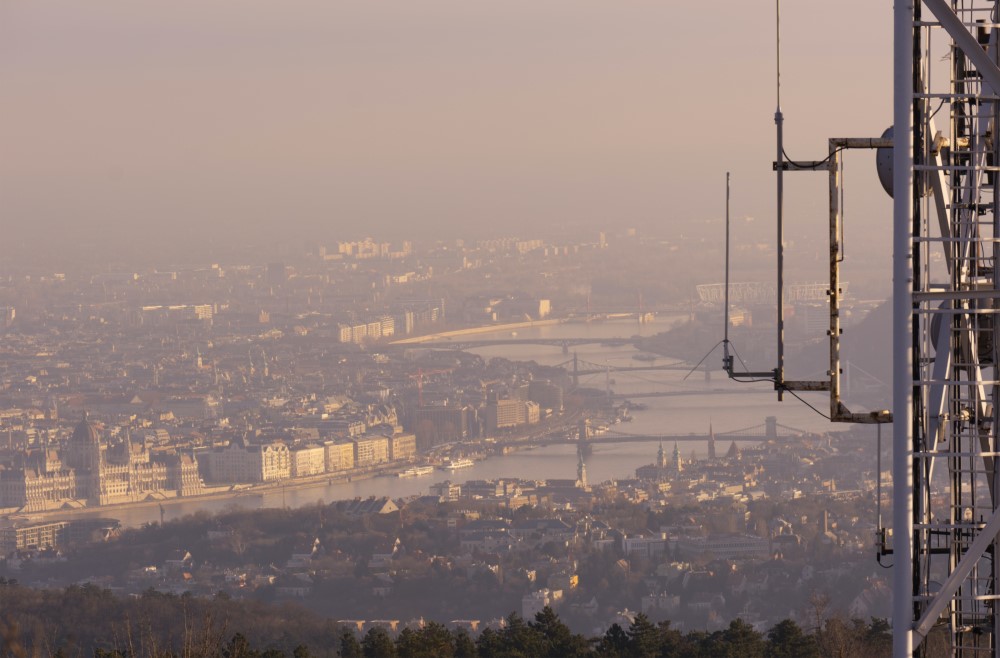
3/10
Figure 2: Smog in Budapest. Photo: József Koller | Unsplash
In Hungary, a substantial part of air pollution is attributable to the heating of buildings, industrial activity, solid fuel burning (heating with wood and waste incineration) and transportation (Figure 3). The number of cars per 1 000 citizens grew from 299 to 390 in the country between 2010 and 2019 [7], and, although an increasing part is alternatively powered (electric, hybrid etc.), vehicular emission rates have not yet decreased.

4/10
Figure 3: Main sources of air pollution in the EU, 2017. Source: European Court of Auditors [8]
Thoughtful urban planning would mitigate the problem
The dominant urban planning practices of recent decades – apart from being in many regards outdated by now – have not been able to improve the situation. Dense urban structures with large building masses substantially impede natural ventilation, causing the polluted air to easily get stuck between buildings. Furthermore, car-centric traffic planning and large paved surfaces (Figure 4) decrease the ratio of biologically active vegetation cover, reducing the natural absorption of pollutants by plants and exacerbating the local heat island effect. A striking fact is that in Budapest, only 5 m2 of green area is available per capita on average, compared to a minimum of 9 m2 per capita recommended by the WHO.

5/10
Figure 4: Plethora of paving stones at Arany János Metro Station, Budapest. Photo: ABUD
From a sustainability point of view, further negative effects come to life if the necessary interventions requiring parallel implementation are not performed simultaneously – not to mention the drawbacks of adopting other “pseudo-solutions”. Examples of the former are introducing traffic restrictions without the development and promotion of sustainable transport, while interventions such as creating shared-use (mostly unsafe) walking and biking paths or multilevel parking structures under the pretext of traffic mitigation illustrate the latter.
Solution: the natural physiological properties of plants
Nature-based solutions relying on the biochemical, biophysical and ecological properties of plants provide a workable solution for air pollution mitigation. Green infrastructure leverages the biophysical absorption of particulate matter and, with gaseous air pollutants, the biofiltration performance of plants. Throughout the course of biofiltration, the absorption, breakdown and utilisation of pollutants take place in close cooperation with the microorganisms on leaves and in the root zone – within the framework of the internal biochemical and ecological processes of plants [10]. Certain tree species and shrubs are especially effective in mitigating carbon dioxide and PM particles. Papilionaceous plants are used for adsorbing and utilising atmospheric nitrogen, while indoor plants as common as aloe vera and ivy act as effective absorbents of volatile organic compounds
Certain plants and plant communities function as bioindicators, marking air pollution levels by producing visible irregularities such as traces of contamination (e.g. leaf spotting, discolouration of leaves). Such plants are tobacco and clover (besides being well-known ozone indicators), as well as lichen that indicate the presence of nitrogen oxides and sulphur oxides.
Practical examples from a holistic approach
The mitigation of air pollution via NbS is mostly done through various green façades and green roofs, landscaping, planting projects, and the development of further components of green infrastructure (Figure 5).
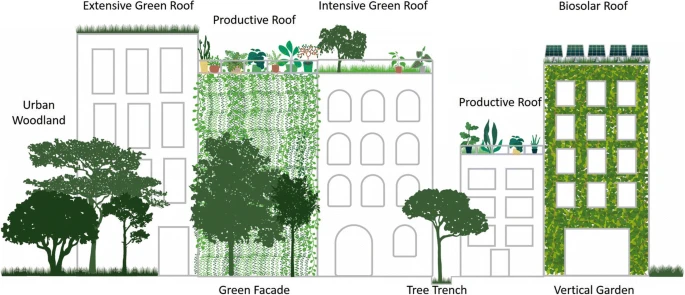
6/10
Figure 5: A few examples of NbS in cities suitable for air purification. Source: Calheiros & Stefanaikos, 2021 [11]
Within the framework of the EU-funded iSCAPE project several innovative solutions for improving air quality were studied with the participation of 6 European cities between 2016 and 2019. The results have shown that properly designed and placed tree and shrub rows, green roofs and green façades can mitigate the exposure to particulate matter by as much as 50%, while attenuating the heat island effect through controlling the local microclimate.
However, certain design aspects are worth taking into account during the preparation phase of applying nature-based solutions in order for their effective and permanent functioning. Being a form of system design, the principles of adaptive environmental impact management (optimised for air pollution) should be followed (Figure 6). The mitigation hierarchy of polluted air begins with needs reduction (e.g. transportation, production) and the consideration of the principles of sustainable urban design. After that, the emphasis shifts to resource utilisation. The final stages include the strengthening of social resilience, bioindication, and the creation and operation of self-sustaining ecosystems, including the comprehensive monitoring of results.

7/10
Figure 6: The hierarchy of treating polluted air. Source: ABUD
Multifunctionality must be a priority when applying nature-based solutions, as we prepare complex solutions with variable demands for space – ones that are able to significantly improve air quality when correctly combined with other types of interventions. The space demand, appropriate sizing and placing of green infrastructure components depend mainly on their context: the type and distribution of pollution; building density; the properties of suitable plant species; geography, and climatic conditions of the given location are all contributing factors. The application of such quantitative indicators as the leaf area index – determining the size of the leaf area compared to the size of the ground surface – is very helpful throughout planning. With the consideration of these indicators, air composition measurements have shown that as much as a 90% decrease can be attained in the concentration of certain air pollutants by installing hedges or green walls in open spaces along roads (Figure 7) [13].

8/10
Figure 7: The spread of air pollutants in open spaces without vegetation (a), with vegetation (b), and with green walls (c). Source: Abhijith et al., 2017
In case we decide to apply NbS, the most important preliminary step is to choose the plant species that is most appropriate for the environmental conditions and the type of pollution. In order for the plant to function beneficially for air quality in the long term, it is vital to take care of the plants that are permanently exposed to pollution, by providing them with appropriate soil conditions, nutrient supply and plant protection necessary for their healthy growth. These measures are more cost-effective than the installation of new vegetation, both environmentally and economically.
Best practices of green infrastructure development
An excellent example of designing with NbS is the JUSTNature Project in Szombathely, Hungary, coordinated by ABUD and funded by the EU. The project’s integrated green infrastructure development simultaneously promotes social urban renewal; the abatement of air pollution caused by traffic; the mitigation of urban heat island effect; natural habitat creation and awareness raising [15].
Throughout the project, an underused half-hectare area in the neighbourhood of Gyöngyös Brook was turned into an urban forest, which was the missing link for the creation of an ecological corridor along the brook. The forest’s primary functions are air filtration along the road and the bioindication of air pollution. A secondary function serves as an outdoor recreational amenity in an underdeveloped area that lacks public open spaces. At the same time, a green wall, some green surfaces, elevated garden beds, crop production and livestock handling facilities are being created by redesigning the concrete-paved courtyard of a nearby primary school. These interventions allow for the formation of a more pleasant microclimate (including cleaner air) and the education of children on environmental responsibility. The cornerstone of the latter being an educational trail along the brook. For the purpose of long-term functioning, local citizens and professional organisations were invited to form a cooperative and supportive community: a so-called green infrastructure community, facilitating more equal access to environmental assets.
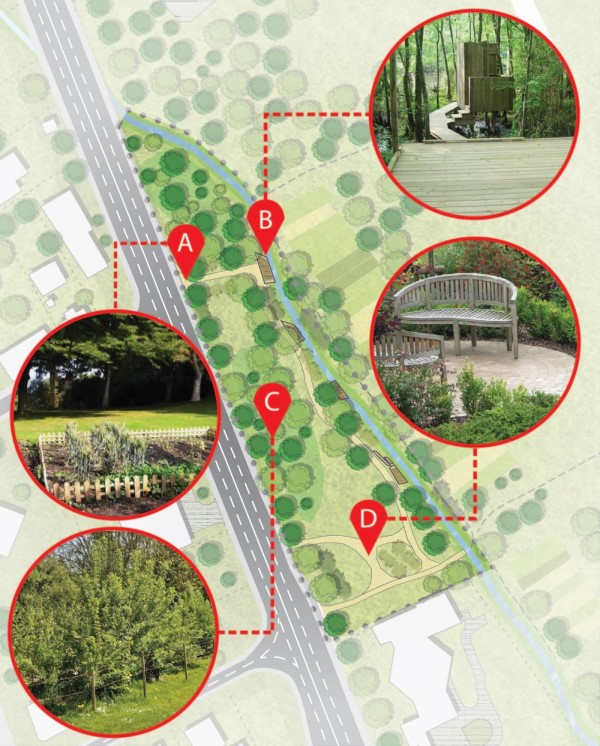
9/10
Figure 8: The urban forest concept realised by the JUSTNature Project of Szombathely. Source: ABUD
Modelling and simulation also offer a variety of exploitable opportunities while designing NbS. The example of Stuttgart clearly demonstrates that even geographic conditions – that are disadvantageous regarding air pollution – can be overcome with proper urban design. Climatic forecasts predicted the doubling of extremely hot days for 2050 in the region. With the intention of prevention, detailed measurements and monitoring of the local climate took place from the 80s including regular measurements of predominant wind flows; flows of cold and warm air and the concentration of air pollutants. Based on the gathered data, specific regional climate models served as the basis of an array of urban design studies. Following a comprehensive climate adaptive transformation, currently, green ventilation corridors (Figure 9) ensure the inflow of fresh air from surrounding heights, making the air cleaner and reducing the heat island effect [16].

10/10
Figure 9: Some components of the Stuttgart green corridors: grassy turfs along tram rails, rows of trees (left side) and green roofs (right side). Source: Urban Climate Stuttgart [17]

Besides improving air quality, the project facilitated the minimisation of noise pollution; restoration of the natural local ecosystem; enhancement of biodiversity; reduction of temperature, and the continuous deep involvement of different social groups.
Conclusion
Though air quality has become a problem of growing significance for large cities, NbS offer reasonable and achievable ways to mitigate pollution. Similarly to the topic of rainwater management, these interventions require integrated design and a holistic approach. Although the process of green infrastructure development is complex, demanding large spaces and continuous maintenance, in turn, it offers opportunities for urban renewal, social value creation, awareness raising, and the establishment of a healthier environment. In order for their realisation to be successful, it is indispensable to involve local citizens in the design phase – taking into consideration their needs and experiences as well as the results of computer-based simulations – and to find the points of intervention where different components and functions of green infrastructure can strengthen each other. Nature-based solutions cannot, on their own, compensate for the fundamental deficiencies of urban planning, nevertheless, – provided they are put appropriately into the intervention hierarchy– they enable access to cleaner air in cities.
Authors
Péter Párdi – Consultant, ABUD – Advanced Building and Urban Design
Viktor Bukovszki – Senior Consultant, ABUD – Advanced Building and Urban Design
References
[1] ENSZ Emberi Jogi Tanácsa (2021): HRC/RES/48/13. URL: https://www.ohchr.org/en/hr-bodies/hrc/regular-sessions/session48/res-dec-stat
[2] Egészségügyi Világszervezet (2018): URL: https://www.who.int/news/item/02-05-2018-9-out-of-10-people-worldwide-breathe-polluted-air-but-more-countries-are-taking-action
[3] Európai Számvevőszék (2018): Különjelentés – Légszennyezés: egészségünk védelme még mindig nem elégséges. URL: https://www.eca.europa.eu/Lists/ECADocuments/SR18_23/SR_AIR_QUALITY_HU.pdf
[4] WHO (2018): Ambient air pollution attributable DALYs (per 100 000 population). URL: https://www.who.int/data/gho/data/indicators/indicator-details/GHO/ambient-air-pollution-attributable-dalys-(per-100-000-population)
[5] Európai Környezetvédelmi Ügynökség (2018): Unequal exposure and unequal impacts: social vulnerability to air pollution, noise and extreme temperatures in Europe. URL: https://www.eea.europa.eu/publications/unequal-exposure-and-unequal-impacts
[6] Éghajlatváltozási Kormányközi Testület – IPCC (2022): Hatodik Értékelő Jelentés, II. Munkacsoport. URL: https://www.ipcc.ch/report/ar6/wg2/
[7] TeIR Helyzet-Tér-Kép (2022). URL: https://www.teir.hu/helyzet-ter-kep/
[8] Európai Számvevőszék (2018): Különjelentés – Légszennyezés: egészségünk védelme még mindig nem elégséges. URL: https://www.eca.europa.eu/Lists/ECADocuments/SR18_23/SR_AIR_QUALITY_HU.pdf
[9] Zöld Zugló Közösségi Klímastratégia – Zugló Klímavédelmi Terve (2021). URL: https://www.zugloklimastrategia.hu/wp-content/uploads/2021/06/Zuglo_Klimastrategia_2021_06_10.pdf
[10] European Commission, Directorate-General for Research and Innovation, Calfapietra, C., Nature-based solutions for microclimate regulation and air quality: Analysis of EU-funded projects, (2020). URL: https://data.europa.eu/doi/10.2777/383904
[11] Calheiros, C.S.C., Stefanakis, A.I. (2021): Green Roofs Towards Circular and Resilient Cities. Circ.Econ.Sust. 1, 395–411. URL: https://doi.org/10.1007/s43615-021-00033-0
[12] URL: https://www.iscapeproject.eu/results/
[13] K.V. Abhijith et al. (2017), Air pollution abatement performances of green infrastructure in open road and built-up street canyon environments – A review. Atmospheric Environment, Volume 162, 2017, Pages 71-86, URL:, https://doi.org/10.1016/j.atmosenv.2017.05.014.
[14] Barwise, Y., Kumar, P. (2020): Designing vegetation barriers for urban air pollution abatement: a practical review for appropriate plant species selection. npj Clim Atmos Sci 3, 12. URL: https://doi.org/10.1038/s41612-020-0115-3
[15] URL: https://justnatureproject.eu/labs/szombathely
[16] City of Stuttgart and Green and Blue Space Adaptation for Urban Areas and Eco Towns (GRaBS), (2021). URL: https://climate-adapt.eea.europa.eu/metadata/case-studies/stuttgart-combating-the-heat-island-effect-and-poor-air-quality-with-green-ventilation-corridors
[17] URL: http://www.stadtklima-stuttgart.de/index.php?info_diashow_en
